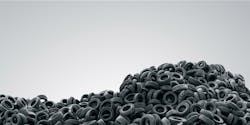Cooking Oil and Tires: The Future of Biofuel?
An Oak Ridge National Laboratory-led research team has developed a method of converting used cooking oil – with the help of the reusable carbon material from old rubber tires – into biofuel, according to a study recently detailed in Chemistry Select.
In a collaboration with researchers from Wake Forest University and the Georgia Institute of Technology, the study reveals how biofuels can be produced inexpensively, environmentally friendly and with high value, which is a major step toward greater biofuel production.
The process combines modified, recovered carbon with sulfuric acids, which is in turn mixed with free fatty acids found in household vegetable oil to produce usable biofuel.
“This report demonstrates a new direction for the design of solid acid catalysts by emphasizing the use of carbon derived from waste tires and environmentally benign protocols for surface modification,” writes the research team. “The obvious advantages of STC-cys catalyst include relatively benign functionalization process involving L-cysteine, very good catalytic performance and stability. The work shows promise for both green and economic production of biofuels using inexpensive FFA-rich feedstocks. The sulfonated, tire-derived carbon should also find use in acid-catalyzed chemical reactions beyond biofuel applications.”
